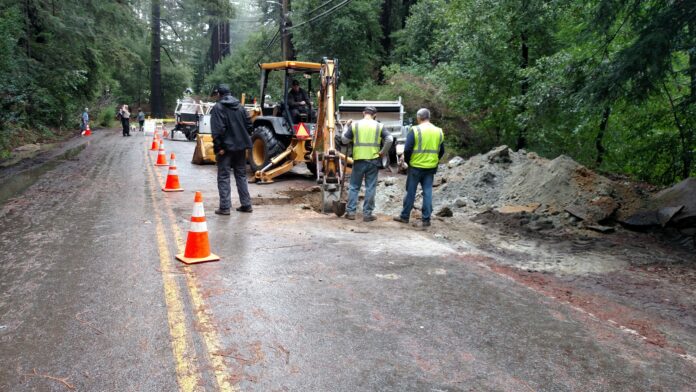The San Lorenzo Valley Water District has no current storm-related disruptions in water service, despite the heavy rains that have inundated the Santa Cruz Mountains since the weekend.
The most significant storm damage the District sustained since storms began pummeling the San Lorenzo Valley on Saturday was a rupture to a main pipeline running under Bear Creek Road. The pipe was damaged when a large section of the road was washed away Sunday night, Jan.8.
Water district crews rerouted water service in the area through a bypass pipe that connects around the damaged area of the water line.
The crews also repaired a couple of leaks in Lompico on Tuesday morning and have been working hard to deliver generators to pumps in areas where the power is out. Crews also are navigating around downed trees, but no roads essential to providing water service have been closed.
The San Lorenzo River peaked at 20 feet overnight onTuesday, 2 feet over flood stage.
Despite the storm, there are no water quality issues or special use restrictions affecting San Lorenzo Valley Water District customers.
Water service has not been disrupted, though surface water intakes were shut off earlier in the week due to turbidity (typical as a consequence of muddy creek water). The District is relying on well water to supply customers.
However, high groundwater levels inundated the collection system at the District’s Bear Creek Estates wastewater facility from mid-day Monday to Wednesday morning, causing untreated water to flow into Bear Creek. District customers do not get water from this source and this did not impact drinking water.
Santa Cruz County and the Central Coast Regional Water Quality Control Board advise people to stay out of the water and not consume it until three days after the rain ends, the standard notice.
Also, San Lorenzo Valley water customers are not impacted by the City of Santa Cruz’s call for additional conservation following a pipeline break in its system. Water quality is also not affected, district managers reported.
In Scotts Valley, the water district reported no problems in connection with the storms.
The Scotts Valley Water District did announce this week that it has installed a new weather station at the District’s El Pueblo facility.
The new weather station replaces an older-style rain gauge that had been in use for many years. The rain gauge only collected rainfall data and needed to be measured by hand. The new station automatically records and stores information about rainfall, humidity, barometric pressure and wind speed.
Tracking rainfall is important for district that relies on local groundwater as its sole potable water supply and rainfall is the best measure of the potential for recharge of the groundwater basin. Rainfall can also be used as an indicator of irrigation demand. The District has been accumulating daily rainfall data since 1981.
Because the station provides up-to-date information about local weather, the District wanted to make this resource available for the public. Current weather conditions can now be viewed from a link on the homepage of the district website, www.svwd.org
“This is a much-needed tool for district staff, and installing the new station provides a higher level of service to our customers,” District Manager Piret Harmon said. “We hope people will check out the weather data — it’s as local as it gets!”













